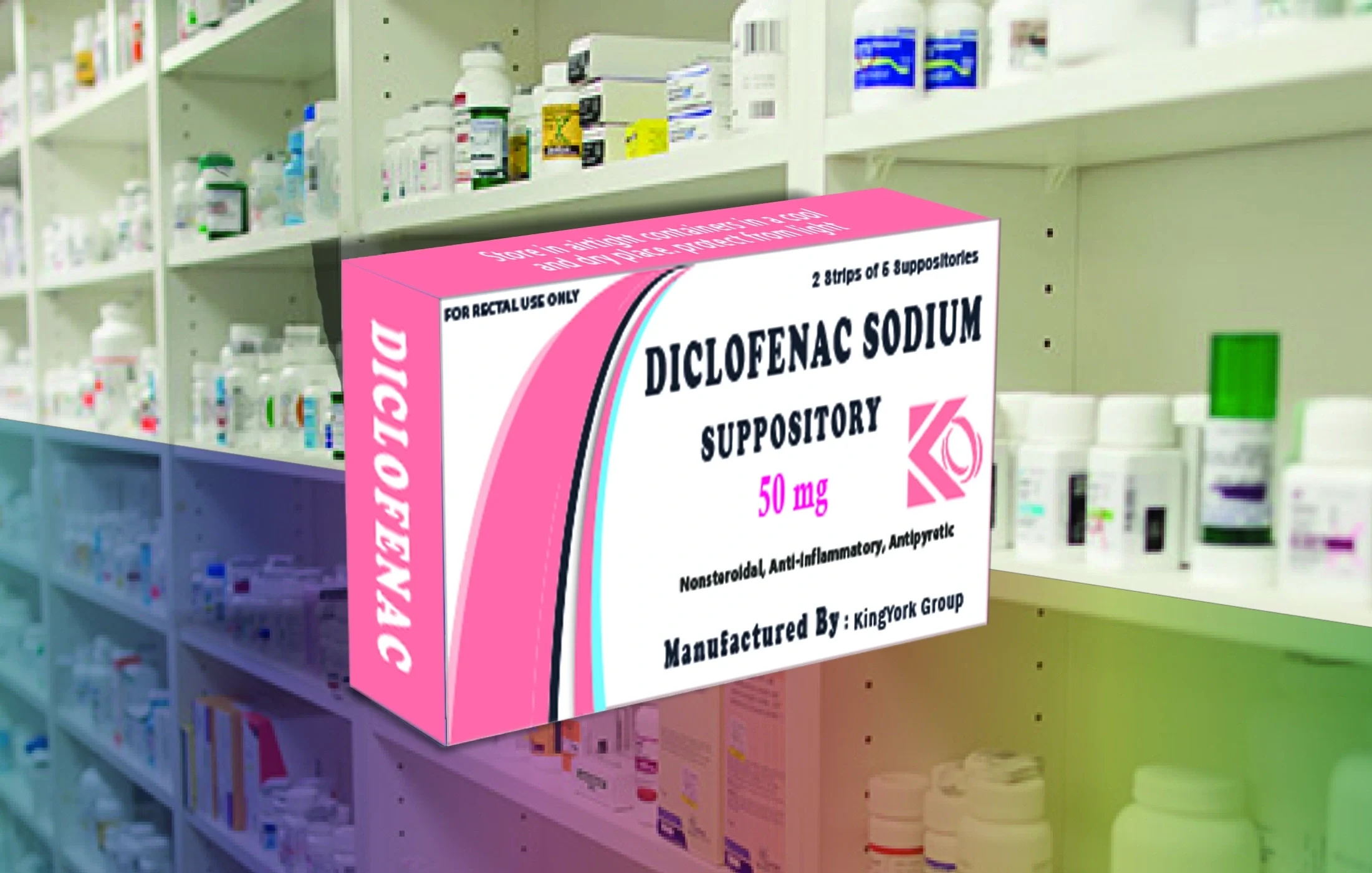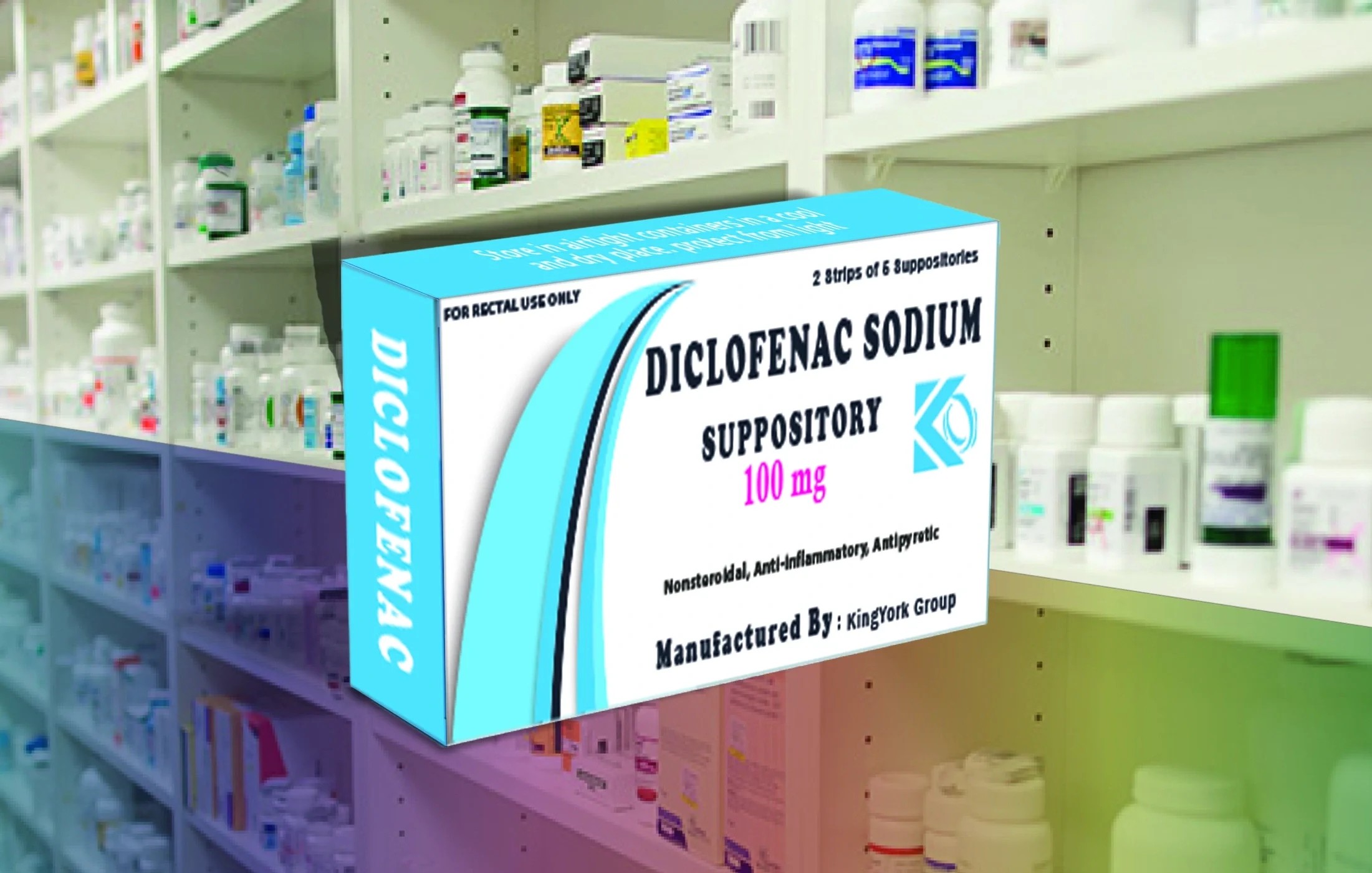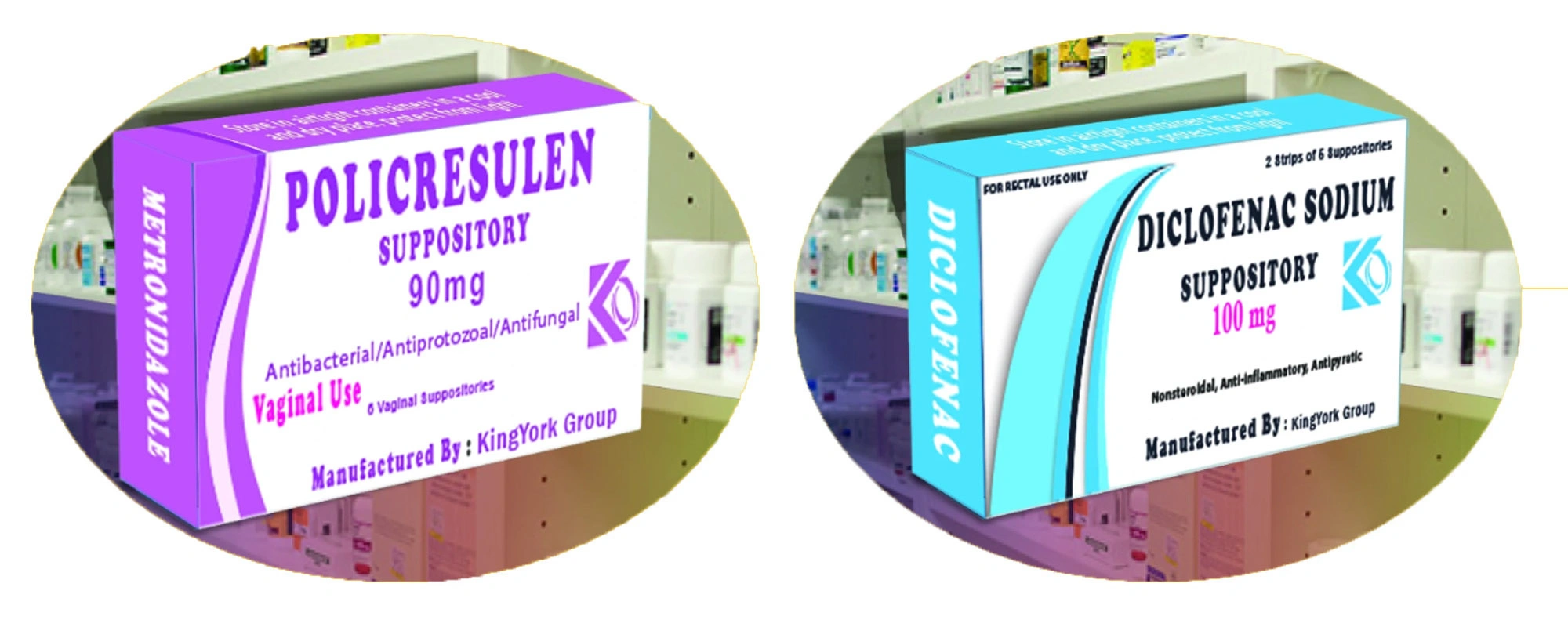Active Pharmaceutical Ingredients
The active pharmaceutical ingredients (APIs) used in suppositories play a critical role in the product's therapeutic effect. When selecting APIs, manufacturers must consider solubility, chemical stability, and bioavailability based on the suppository base ingredients and intended delivery route.
Common active ingredients include:
- Local anesthetics like lidocaine to provide numbness and pain relief in the lower rectal area.
- Laxatives such as bisacodyl and glycerin to induce bowel movements.
- Antifungals like clotrimazole and miconazole to treat vaginal yeast infections.
- NSAIDs including ibuprofen and naproxen for anti-inflammatory effects.
- Acetaminophen for analgesic and antipyretic effects.
The choice of API depends on the condition being treated and the desired localization of effect. For example, hydrocortisone suppositories target hemorrhoid inflammation directly at the source.
Regulations play an important role in governing APIs for suppositories. In the United States, the FDA reviews data on an API's safety, efficacy, quality, and intended use as part of the drug approval process. Manufacturers must demonstrate bioequivalence for generic drugs and comply with Good Manufacturing Practices (GMPs) for sourcing and quality control of APIs. Only APIs that are demonstrated to be stable, compatible with the base ingredients, and deliver adequate absorption can be used in approved pharmaceutical suppositories.
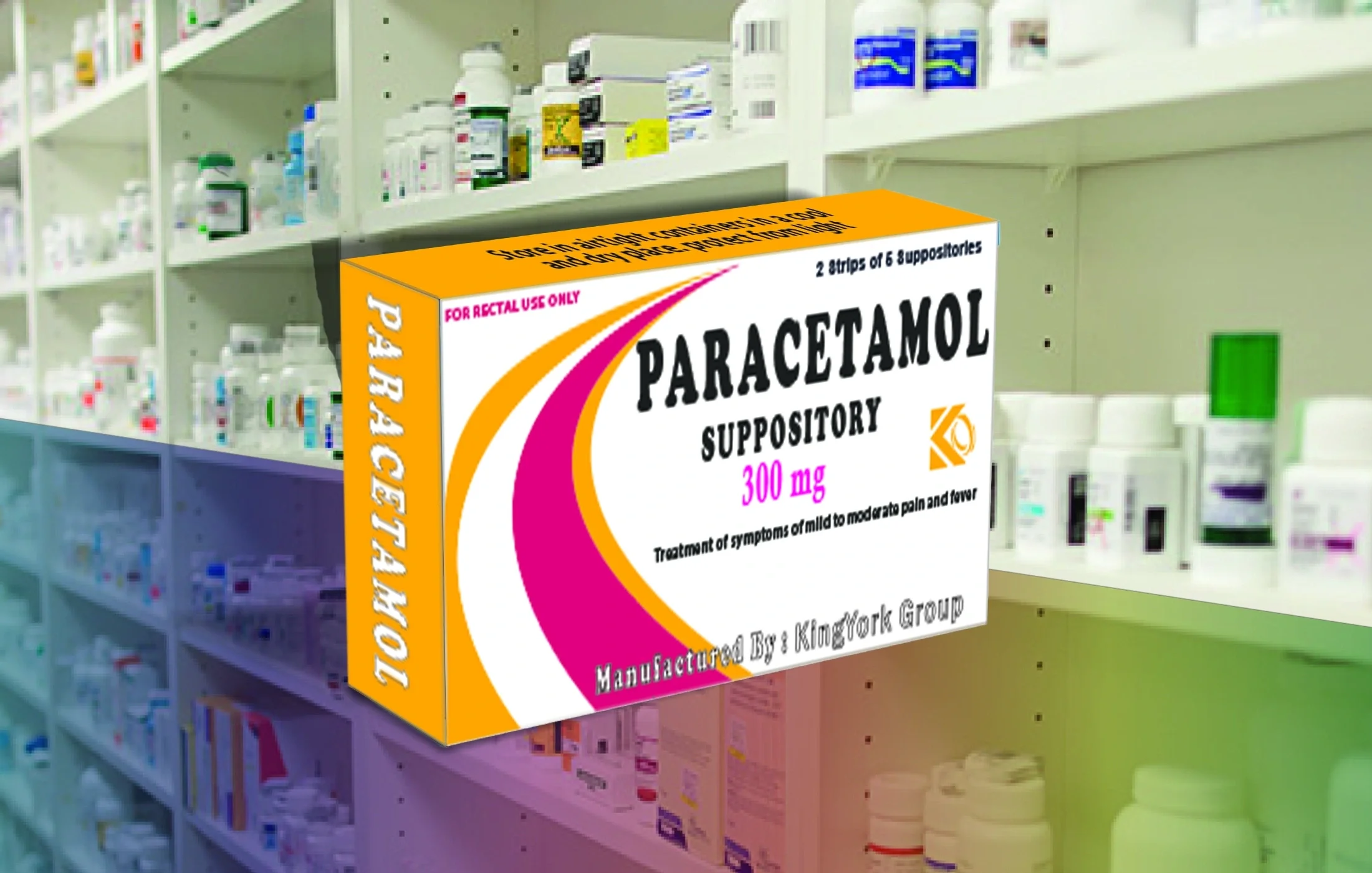
Paracetamol suppository
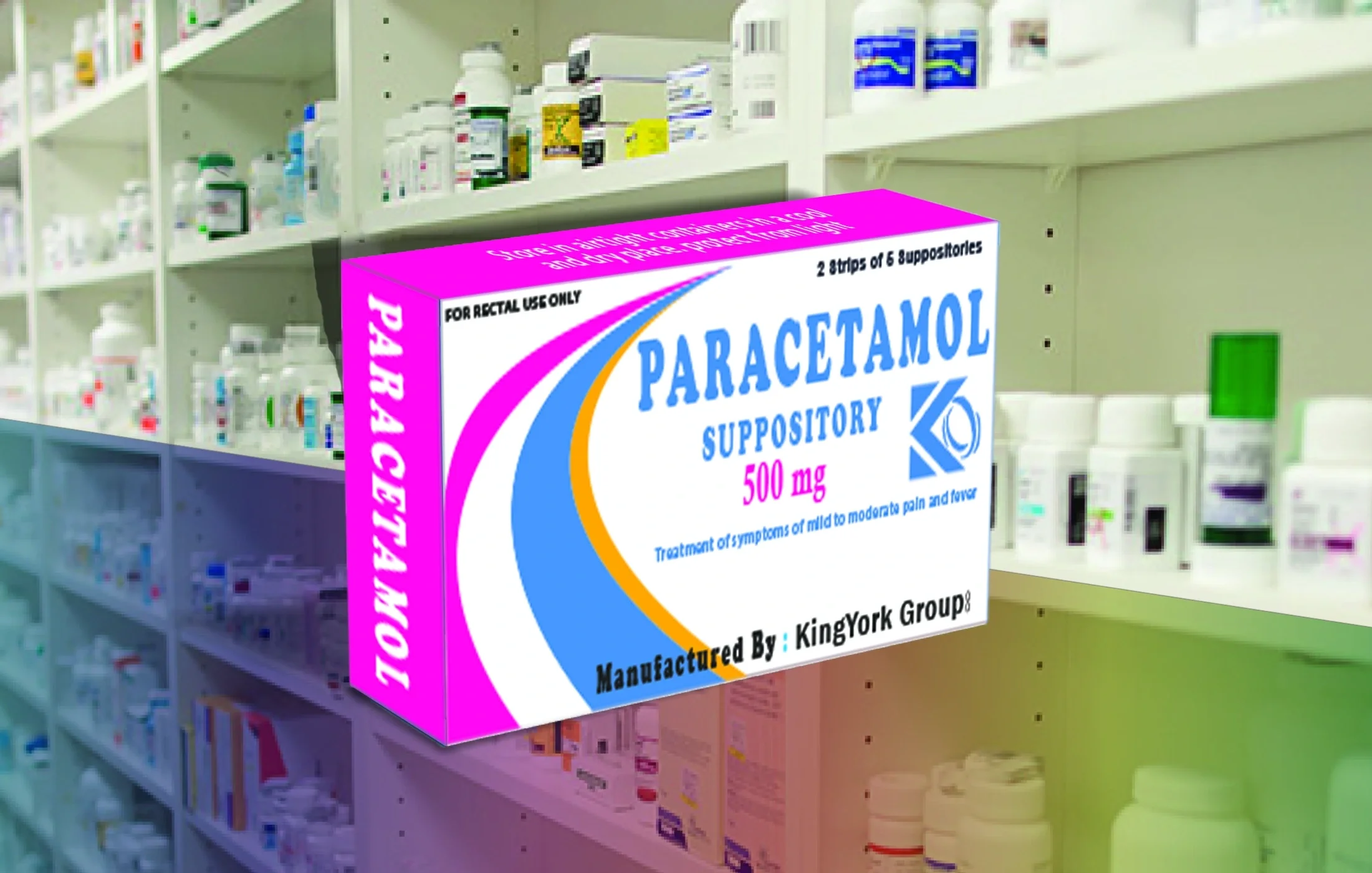
Paracetamol suppository
pharmaceutical suppositories:Base Ingredients
The base plays a critical role in pharmaceutical suppositories. It serves as the vehicle to deliver the active pharmaceutical ingredient (API) and facilitates its absorption. The ideal base should be compatible with the API, provide optimal release of the drug, and be stable throughout the shelf life of the product.
There are several types of bases commonly used in suppository manufacturing:
- **Cocoa butter**
- A natural vegetable fat extracted from cocoa beans. It melts at body temperature and is appropriate for APIs that are dispersed in the base. Cocoa butter suppositories provide slow, sustained release.
**Glycerinated gelatin**
- A water-soluble base made by combining gelatin with glycerin. It is an excellent choice for water-soluble APIs and provides a rapid release upon insertion.
- **Polyethylene glycols**
- Synthetic polymers available in different molecular weights. They have good solubility, dispersibility and are non-irritating to mucosal membranes.
- **Fatty acid esters**
- Esters prepared from fatty acids like lauric, palmitic and stearic acids. They offer versatility in release rates based on their composition.
The selection of an optimal base depends on the API, intended drug delivery profile, stability requirements and manufacturing considerations. Factors like melting point, hydrophobicity, dispersibility and compatibility with the API influence the choice. The base must solidify rapidly after manufacturing for convenient handling and application. A balance between adequate rigidity and melting at body temperature is desirable.
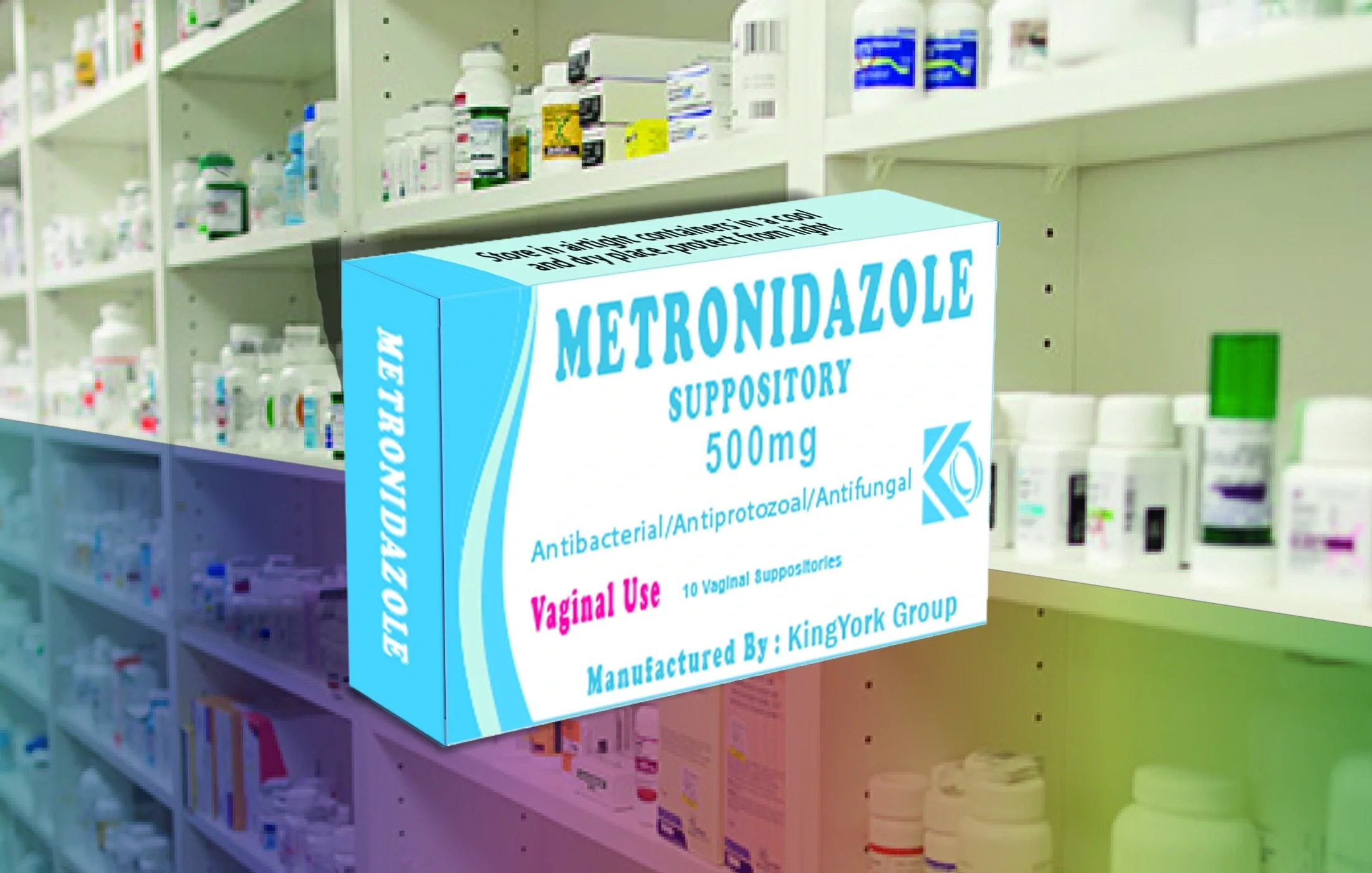
Metronidazole suppository
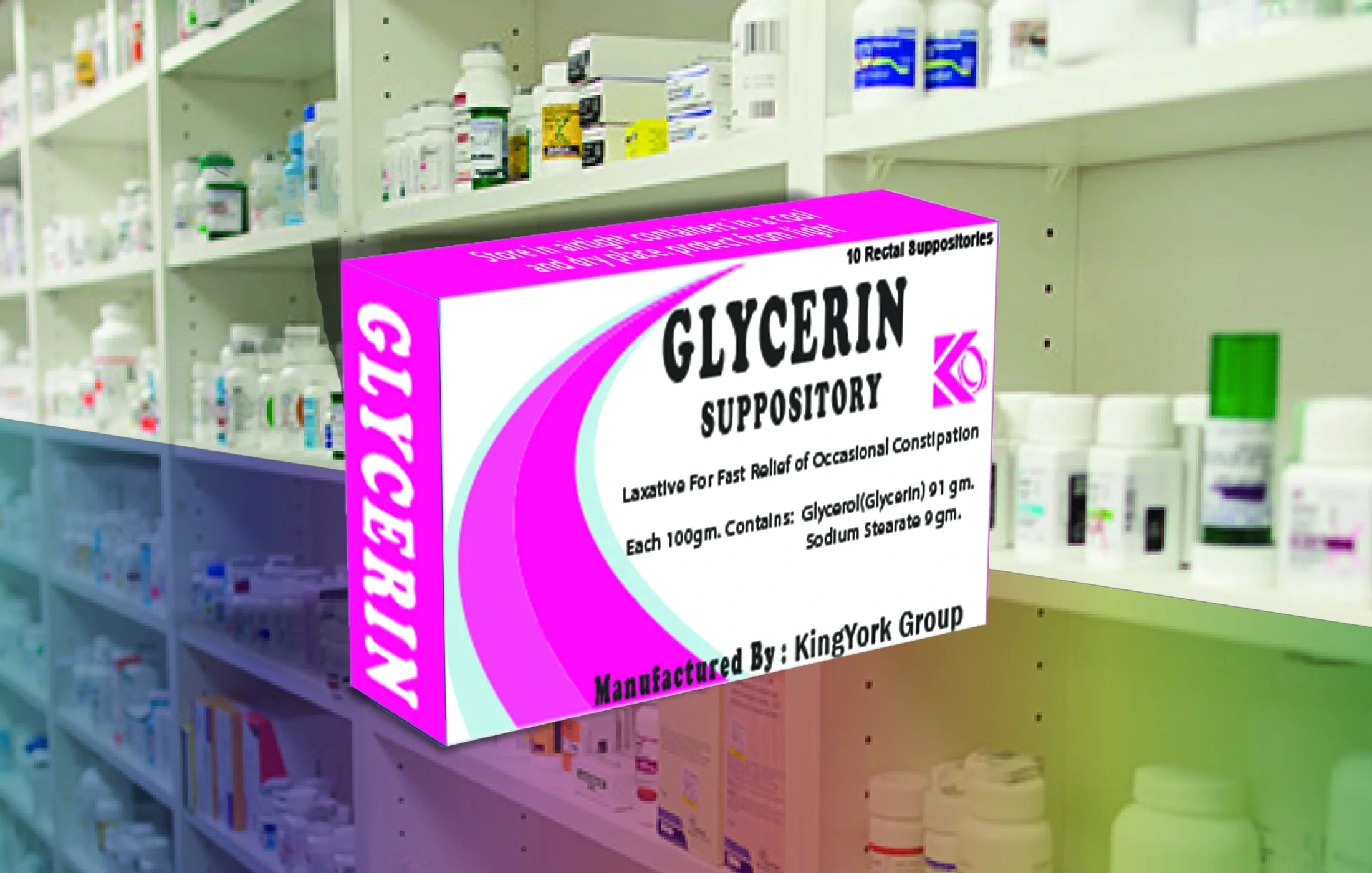
Glycerin suppository
Manufacturing Process
The manufacturing process for pharmaceutical suppositories involves several key steps:
- **Overview of manufacturing steps**
- The main steps include preparing the base ingredients, melting them, mixing in the active pharmaceutical ingredients, pouring the mixture into molds, allowing them to cool and solidify, then packaging the finished suppositories. Strict quality control is maintained throughout.
- **Melting base ingredients**
- The base material, typically a substance like cocoa butter, glycerinated gelatin, or polyethylene glycols, is melted using a steam jacketed kettle or microwave heating system. The temperature is precisely controlled to ensure proper melting without degrading the base ingredients.
- **Mixing with active ingredients**
- Once the base is melted, the active pharmaceutical ingredients are blended in using a high-shear mixer. The active ingredients are ground into a fine powder before addition to promote proper dispersion and dissolution. Mixing continues until a homogeneous mixture is achieved.
- **Pouring into molds**
- The uniform liquid mixture is then poured into suppository molds, which are typically made of plastic or metal. The molds are designed to produce suppositories of standardized sizes and shapes, like bullet-shaped or oval. Molds are prepared by cleaning and lubricating them prior to the pouring step.
- **Cooling and packaging**
- After pouring, the filled suppository molds are cooled at controlled temperatures to solidify the base and active ingredient mixture into solid suppositories. This is a critical step, as cooling rate impacts the final product crystal structure. Once cooled and solidified, the suppositories are ejected from the molds and inspected before primary and secondary packaging.
Proper process controls and in-process quality checks at each manufacturing step ensure the production of quality suppositories that meet specifications. Automation has streamlined many aspects of manufacturing as well. The end result is a cost-effective process that produces uniform suppositories at pharmaceutical grade standards.
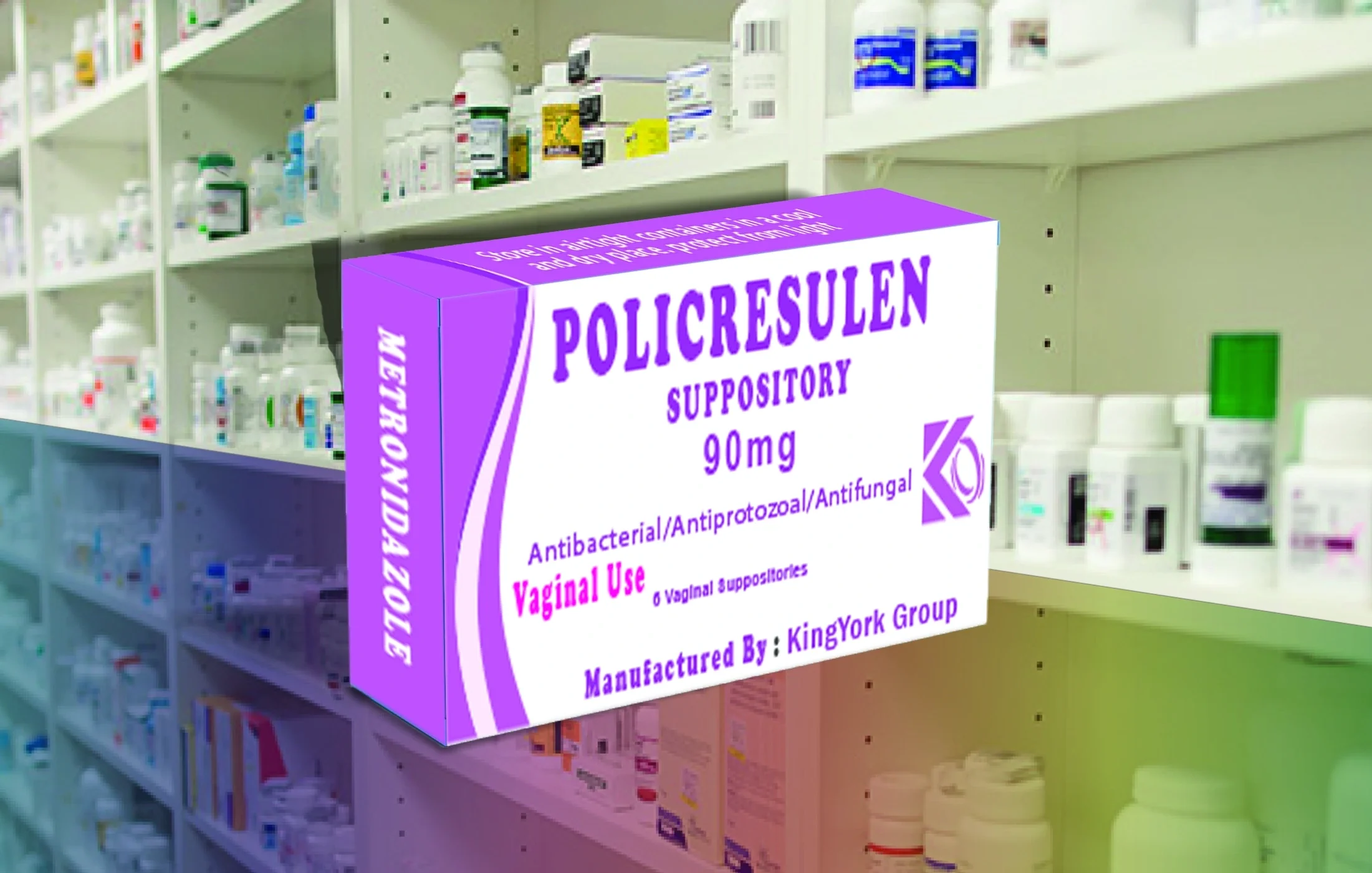
Policresulin suppository
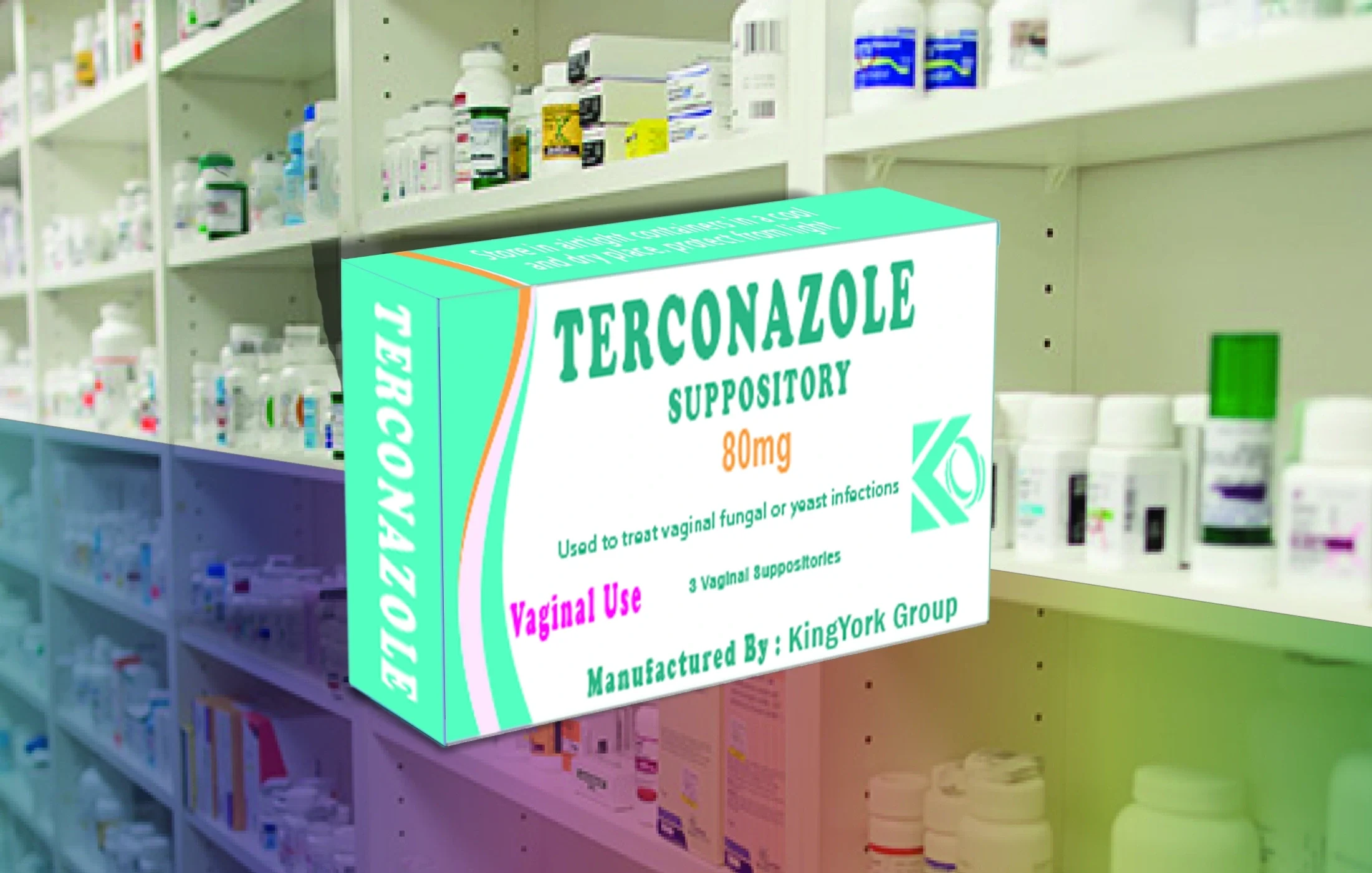
Terconazole suppository
Quality Control
Quality control is a critical part of pharmaceutical suppository manufacturing. Suppositories must meet stringent quality standards to ensure efficacy, safety, and consistency.
Some key aspects of quality control for suppositories include:
- **Tests for Uniformity of Dosage Units:**
These include weight variation testing and content uniformity testing. Weight variation ensures each suppository contains the correct amount of active ingredients. Content uniformity verifies the active ingredient is evenly distributed within each suppository. Limits are set for acceptable variation.
- **Disintegration Testing:**
Measures the time it takes for a suppository to disintegrate. This ensures proper release of the active ingredient once administered. Disintegration time limits are established.
- **Physical Property Testing:**
Checks attributes like melting range, hardness, friability, and appearance. These tests confirm suppositories have the correct physical properties for safe administration and dissolution.
- **Microbiological Testing:**
Screens for objectionable microorganisms like pathogens. Ensures product sterility.
- **Stability Testing:**
Exposes suppositories to various conditions over time to verify they retain their quality. Tests chemical and physical stability.
Proper quality control following Good Manufacturing Practices (GMP) guidelines is essential. GMP dictates requirements for quality systems, control of processes and materials, qualifications of personnel, design of facilities and equipment, documentation, and more. Rigorous quality control ensures suppositories consistently meet purity, identity, strength, and quality standards for patient safety and treatment effectiveness.

Policresulin suppository

Terconazole suppository
Machinery and Equipment
The manufacture of pharmaceutical suppositories requires specialized equipment and machinery to enable efficient and precise production. Some key pieces of equipment include:
- **Suppository molds** - These metal molds come in various sizes and shapes depending on the desired dosage and type of suppository being produced. The molds have cavities that allow the suppository base to be poured and cooled into the proper shape. Molds are precisely engineered for consistency in sizing.
- **Melting and mixing equipment** - Suppository bases like cocoa butter or glycerinated gelatin need to be melted at specific temperatures to ensure proper blending with active ingredients. Jacketed kettles and tanks allow close control over heating of the base components. Agitators and mixers are used to thoroughly incorporate any active pharmaceutical ingredients and achieve a homogeneous mixture.
- **Cooling equipment** - Once the molten base is mixed, it must be cooled and solidified into the suppository molds. Cooling tunnels or refrigerated rooms allow controlled cooling at optimal temperatures for the base ingredients used.
- **Filling and sealing equipment** - Automated filling machines precisely dispense the heated liquid base into suppository molds. Some molds are also sealed or compression-formed to shape the suppositories.
- **Packaging equipment** - After cooling and hardening, suppositories are ejected from molds and packaged, often using flow wrap machinery. Tablet presses may be used to package into blister packs.
With pharmaceutical-grade machinery and temperature/pressure-controlled manufacturing, facilities can produce suppositories with the highest quality and consistency. The right equipment helps them meet regulatory standards.
Facility Design
Facility design is a critical consideration in the manufacturing of pharmaceutical suppositories. Strict clean room requirements, temperature and humidity controls, and efficient workflow must all be taken into account.
Clean Room Requirements
Suppositories are considered pharmaceutical preparations, and their manufacture requires clean room conditions. Clean rooms used in suppository production should meet ISO standards such as ISO 14644 or EU GMP Annex 1. Key requirements include:
- Air filtration to remove particulates
- Clean room garments worn by personnel
- Monitoring of differential room pressures
- Microbial and particulate monitoring
- Smooth cleanable surfaces
- Separate gowning rooms between clean and general areas
Maintaining proper clean room conditions ensures suppository products remain free of contamination.
Temperature and Humidity Control
Precise control of temperature and humidity is vital in suppository manufacturing. ideal conditions prevent variability in the product and ensure quality.
- Temperatures are typically controlled at 20-25°C. Significant fluctuations can impact base ingredient melting properties.
- Relative humidity levels of 30-60% RH prevent static buildup and maintain product stability.
Monitoring systems track temperature and humidity against preset limits. Alerts notify personnel if deviations occur.
Workflow Considerations
The facility layout must allow logical workflow between major production steps:
- Ingredient receipt and quarantine
- Weighing and mixing
- Suppository molding and cooling
- Packaging and labeling
- Secondary packaging and preparation for distribution
Unidirectional flow between areas prevents mix-ups or contamination. Dedicated rooms for each stage can help physically separate processes. Equipment placement aims to optimize material flow and minimize human errors.
Proper facility design establishes the ideal controlled environment for pharmaceutical suppository manufacturing. It combines stringent clean room protocols, precise ambient conditions, and efficient workflow layout.
Regulations
Pharmaceutical suppositories are strictly regulated to ensure safety, efficacy, and quality. Key regulations include:
- Oversight by the FDA and equivalent agencies globally. Companies must register their facilities and follow cGMP (current Good Manufacturing Practices).
- Adhering to cGMP guidelines around quality management, personnel training, building and facility management, equipment maintenance, production and process controls, packaging and labeling, laboratory controls, records management, and complaint handling.
- Rigorous testing and release requirements before products can be distributed. Companies must test raw materials, in-process samples, and finished products to ensure quality specifications are met. Tests confirm product identity, purity, strength, and performance.
- Maintaining stringent quality standards through the entire manufacturing process. Qualified personnel must supervise each step, and all equipment must be properly calibrated.
- Submitting products for regulatory approval and licensing. Companies must provide evidence that the product is safe and effective for its intended use.
- Allowing inspections by regulatory authorities to audit facilities, processes, testing records, personnel qualifications, and all aspects of GMP compliance. Facilities must be ready to be inspected at any time.
- Adhering to regulations around packaging, labeling, storage, and transportation. Products must maintain quality throughout the supply chain.
- Reporting serious adverse events to regulators and investigating product complaints thoroughly. Issues must be addressed to prevent recurrence.
- Providing ongoing stability testing data to regulators to confirm labeled shelf life. Products must retain safety and efficacy for their entire shelf life.
Complying with pharmaceutical regulations is essential for companies manufacturing suppositories. Following GMP guidelines and quality systems helps ensure patients receive effective products without contamination or defects. Regulatory oversight spans the entire product lifecycle.
Trends and Innovations
Pharmaceutical suppositories have seen some interesting innovations in recent years. Here are some of the key trends:
Coated Suppositories
Coated suppositories are gaining popularity as a way to help the medication absorb more efficiently. The coating protects the suppository from melting too quickly, allowing it to penetrate deeper into the rectal tissue before dispersing the medication. Common coatings used include gelatin, cocoa butter, and polyethylene glycols. The coating provides a time-release effect, as well as masking any unpleasant odor or taste of the medication.
Alternative Base Materials
The traditional base ingredients for suppositories like cocoa butter, glycerinated gelatin, and polyethylene glycols have some limitations. New base materials being explored include theobroma oil, hydrogenated vegetable oils, synthetic triglycerides, and polyethelene oxide. These alternative bases can provide a longer shelf life, more precise melting points, and improved stability. Using them can result in suppositories that are easier to manufacture and insert.
New Active Ingredients
In addition to traditional medications like acetaminophen, new active pharmaceutical ingredients are being formulated into suppositories. These include ophthalmic, antiviral, antifungal, antibiotic, anti-inflammatory, and anti-nausea medications. Suppositories allow direct delivery to the bloodstream without undergoing first-pass metabolism in the liver. This makes them ideal for medications that are easily broken down or need rapid absorption. More research is being done on novel medications and drug combinations tailored specifically for rectal suppository delivery.
The Future of Pharmaceutical Suppositories
The pharmaceutical suppository market is poised for continued growth in the coming years. Several key trends are contributing to the positive outlook:
**Projected Market Growth**
- The global pharmaceutical suppositories market size was valued at USD 1.23 billion in 2021 and is expected to expand at a compound annual growth rate (CAGR) of 7.2% from 2022 to 2030.
- Rising demand for alternative drug delivery routes, an aging population, and the increasing prevalence of chronic diseases are key factors driving market growth.
- Europe accounted for the largest revenue share of over 30% in 2021 and will retain dominance through 2030. However, the Asia Pacific market is expected to grow at the fastest pace over the forecast period.
**Potential New Delivery Mechanisms**
- Innovation in suppository delivery mechanisms and formulations represents a major opportunity. Areas of research include:
- Polymer-based suppositories with improved dissolution profiles and extended release capabilities.
- Composite and hollow-type suppositories for larger drug payloads.
- Rectal spray formulations that provide accurate, flexible dosing
- These next-generation delivery methods may improve drug absorption and patient compliance compared to traditional suppository bases like cocoa butter or glycerinated gelatin.
**Reinventing Suppositories with Technology**
- Advances in technology are enabling new approaches to suppository administration that may increase acceptance and use:
- Electronic drug delivery suppositories with programmable, automated release profiles.
- 3D printing of personalized suppositories with custom drug doses and shapes.
- Digital tracking of administration and medication adherence through connected devices.
- Integrating sensor technology and data analytics into suppositories could revolutionize patient monitoring and feedback about the delivery system performance.
- Overall, pharmaceutical suppositories are poised for robust growth and innovation to better serve patient needs in the coming decade. Emerging technology and delivery methods will likely reinvent suppositories and unlock their full therapeutic potential.
Registration:
We will prepare registration documents and certificates as necessary.
Product List - Liquid Injections
| Product Name | �
Strength |
| Vitamin B1 injection |
100mg: 2ml |
| Vitamin B6 Injection |
0.1g: 2ml |
| Vitamin B12 injection |
0.5mg:1ml |
| VIT-B Complex injection |
2ml |
| Tri B-inj B1-100mg+B2-100mg+B12-1000mcg |
3ml |
| Vitamin C injection |
0.5g:2ml |
| VITAMIN K1 injection |
10mg:1ml |
| Dexamethasone Na phosphate injection |
4mg: 1ml |
| Dexamethasone Na phosphate injection |
8mg: 2ml |
| Diclofenac Sodium Injection |
75mg:3ml |
| Metoclopramide hydrochloride injection |
10mg:2ml |
| Metoclopramide hydrochloride injection |
5mg:1ml |
| Iron Sucrose IV Injection |
100mg:5ml |
| Iron Dextran Injection |
100mg:2ml |
| Promethazine Hydrochloride Injection |
50mg:2ml |
| Gentamycin sulfate injection |
40mg:2ml |
| Gentamycin sulfate injection |
80mg:2ml |
| Furosemide Injection |
20mg:2ml |
| Aminophylline Injection |
250mg:10ml |
| Paracetamol injection |
150mg:1ml |
| Paracetamol injection |
300mg:2ml |
| Paracetamol injection |
500mg:4ml |
| Paracetamol injection |
600mg:4ml |
| Paracetamol injection |
750mg:5ml |
| Diazepam injection |
5mg/1ml |
| Diazepam injection |
10mg:2ml |
| Diazepam injection |
5mg/1ml |
| Diazepam injection |
10mg:2ml |
| Oxytocin Injection |
5 iu/1ml |
| Oxytocin Injection |
10 iu / 1ml |
| Chlorphenamine Maleate Injection |
10mg:1ml |
| Hyoscine Butylbromide(Buscopan)Injection |
20mg:1ml |
| Lidocaine Hydrochloride injection |
10ml:0.2g |
| Methotrexate for Injection |
50mg:2ml |
| ENOXAPARIN SODIUM Prefilled syringe |
40MG/0.4ML |
| ENOXAPARIN SODIUM Prefilled syringe |
60MG/0.6ML |
| ENOXAPARIN SODIUM Prefilled syringe |
80MG/0.8ML |
| Adrenaline(Epinephrine HCL)Injection |
1mg:1ml |
| Testosterone 250mg:1ml |
250mg:1ml |
Product List - Vial Injections
| Product Name |
Strength |
| Omeprazol 40 mg IV VIAL |
10ml or 5ml |
| Pantoprazole Sodium for Injection |
40mg |
| Lansoprazole for Injection |
30 mg |
| Ceftriaxone 1gm/10ml IV VIAL |
+10ml water |
| Ceftriaxone 1gm/10ml VIAL |
+Lidocain 1% |
| Ceftriaxone IM/IV VIAL |
500mg/15 ml |
| Ampicillin Na VIAL |
0.5 g/Vial |
| Ampicillin Na VIAL |
1g/Vial |
| Cefotaxime Sodium for VIAL |
1g/Vial |
| Ceftazidime For I.M/I.V VIAL |
1g/Vial |
| Cefepime For I.M/I.V VIAL |
1g/Vial |
| Meropenem VIAL Injection |
1g/20ml/Vial |
| Procaine Penicillin(0.4mega/7ml) |
400.000 U/7ml |
| Procaine Penicillin(0.6mega/7ml) |
600.000 U/7ml |
| Procaine Penicillin(1.2mega/7ml) |
800.000 U/7ml |
| Procaine Penicillin (0.8mega/7ml) |
1200.000 U/7ml |
| Benzathine Penicillin for Injection |
1.2mega/7ml |
| Vancomycin Hcl injection 500mg |
500mg/Vial |
| Vancomycin Hcl injection 500mg |
1g/Vial |
| Heparin Sodium Injection |
5ml:5000 units |
| Heparin Sodium Injection |
5ml:25000 units |
| Amoxicillin Na and Clavulanate Potassium for Inj(augmentin) |
G Powder 1.2 |
| Amoxicillin Na and Clavulanate Potassium for Inj(augmentin) |
G Powder 0.6 |
| lyophilized Hydrocortisone Na Succinate |
3ml:0.1gm |
| aseptic lyophilized Hydrocortisone Na Succinate |
7m:0.1gm |
| Phenobarbital Sodium Injection |
1ml:0.1g |
| Piperacillin Sodium and Tazobactam Na for Inj |
4.5g |
Product List - IV INFUSION
| Product Name |
Strength |
| Paracetamol 1G IV infusion |
100ml glass bottle |
| Metronidazole 500mg IV infusion |
100ml glass bottle |
| Ciprofloxacine 200mg IV infusion |
20ml plastic bottle |
| 0.9% Na Chloride IV Inj |
500ml plastic bottle |
| 5% Glucose Injection |
250ml:12.5g,500ml:25g |
| 10% Glucose Injection |
250ml:12.5g,500ml:25g |
| Sodium Lactate Ringer`s Inj |
500ml Plastic Bottle |
| 5% Glu + 0.9% Na Chlorid inj 250ml: |
Glu 12.5g,NaCl 2.25g |
| 5% Glu + 0.9% Na Chlorid inj 500ml: |
Glu 25g,NaCl 4.5g |
| 10% Glu + 0.9% Na Chlorid inj 250ml: |
Glu 25g,NaCl 2.25g |
| 10% Glu + 0.9% Na Chlorid inj 500ml: |
Glu 50g,NaCl 4.5g |
| Mannitol injection |
250ml:50g P Bottle |
Product List - SYRUP
| Product Name |
Strength |
| Amoxicillin 125mg + Clavulanic Acid 31.5mg |
100 ml glass Bottle |
| Amoxicillin 250mg + Clavulanic Acid 62.5mg |
100 ml glass Bottle |
| Amoxicillin 400mg + Clavulanic Acid 75mg |
100 ml glass Bottle |
| Azithromycine 100mg |
15ml 1bottle/Box |
| Metronidazole 125mg |
100 ml glass Bottle |
| Metronidazole 250mg |
100 ml glass Bottle |
| Amoxicillin 125 mg |
100 ml glass Bottle |
| Amoxicillin 250 mg |
100 ml glass Bottle |
| Paracetamol syrup 250mg/5ml |
250mg/5ml syrup |
| Ibuprofen Dry Suspension 100mg/5ml |
100ml Suspension |
Product List - TABLETS
| Product Name |
Strength |
| Azithromycine 500mg Tab(3 tabs) |
3 tablets X 1 blister |
| Metronidazole 500mg Tab(14 tabs) |
7 tablets X 2 blisters |
| Ciprofloxacine 500mg TAB(10 tabs) |
10 tablets X 1 blister |
| Amoxicillin 250mg + Clavulanic Acid 125mg(14 tabs) |
7 tablets x 2 blister |
| Amoxicillin 500mg + Clavulanic Acid 125mg(14 tabs) |
7 tablets x 2 blister |
| Amoxicillin 875mg + Clavulanic Acid 125mg(14 tabs) |
7 tablets x 2 blister |
| Nitrofurantoin 100mg Tablets |
10 tablets X 1 blister |
| Aspirin Enteric-coated 500mg |
10 tablets X 1 blister |
| Paracetamol 500mg |
10 tablets X 1 blister |
| Ibuprofen 400mg |
10 tablets X 1 blister |
| Diclofenac Na 400mg |
10 tablets X 1 blister |
| Diclofenac 50mg + Paracetamol 500mg |
10 tablets X 1 blister |
| Folic acid 5mg Tab |
10 tablets X 1 blister |
| Ciprofloxacin Tablets |
10 tablets X 1 blister |
| Doxycycline 100mg Tab |
10 tablets X 1 blister |
| Meloxicam 15mg Tab |
10 tablets X 2 blisters |
| Fluconazole 150mg Tab |
10 tablets X 2 blisters |
| Simvastatin 40mg Tab |
10 tablets X 2 blisters |
| Prednisolone 5mg Tab |
10 tablets X 2 blisters |
| Spiramycin 750,000 unit Tab |
10 tablets X 2 blisters |
| Spiramycin 1,500,000 unit Tab |
10 tablets X 2 blisters |
Product List - CAPSULES
| Product Name |
Strength |
| Amoxicillin 500mg(16 Capsules) |
8 cap X 2 blisters |
| Ampicillin Capsules |
10 cap X 2 blisters |
| Cloxacillin Na Capsules |
10 cap X 2 blisters |
| Piroxicam Capsule |
10 cap X 2 blisters |
| Tetracyline 250 mg Capsule |
10 cap X 2 blisters |
| Oxytetracycline 250mg Capsule |
10 cap X 2 blisters |
| Spiramycin 375,000 unit Cap |
10 cap X 2 blisters |
| Indomethacin 25mg Capsule |
10 cap X 2 blisters |
Product List - Suppository
| Product Name |
Strength |
| Paracetamol 125mg suppository |
5 Supp x 2 blister |
| Paracetamol 250mg suppository |
5 Supp x 2 blister |
| Policresulen Vaginal 90mg Suppository |
4 Supp x 2 blister |
| Chlorhexidine Acetate 20mg Supp |
5 Supp x 2 blister |
| Miconazole Nitrate Vaginal 100mg Supp |
5 Supp x 2 blister |
| Clotrimazole Vaginal 150mg Supp |
5 Supp x 2 blister |
| Metronidazole Vaginal 500mg Supp |
5 Supp x 2 blister |
| Indomethacin 500mg Supp |
5 Supp x 2 blister |
